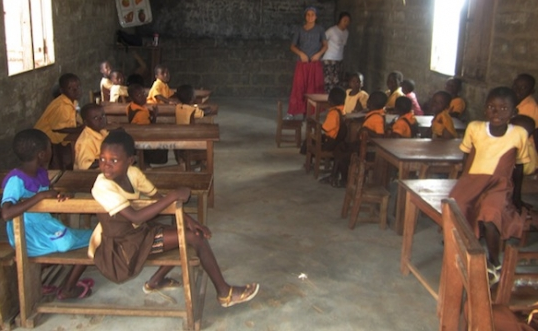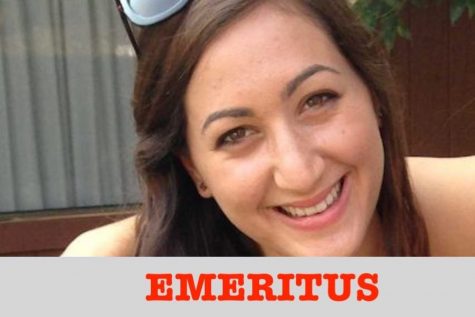The Happy Mystery That Is Ghana

COLORS: Students at New Seed International, an orphanage for kids whose parents died of HIV/AIDS, welcomed guests with a dance and drum ceremony last summer. Bright colors are everpresent in Ghana and often have symbolic, and sometimes nationalistic, meaning, recognizing the country’s independence.
September 1, 2012
In the village of Anloga, Ghana, where I stayed for three weeks this summer, when someone dies people gather in the streets and they dance. Some wear red and black, considered mourning colors, and along with dancing they sing, and they eat. Some of the funeral festivities last for days, filled with merriment and jubilation.
I first encountered a funeral while riding in a car down a main road. People were crowded alongside the street and even in the road itself. They blasted music and howled out of car windows as we drove through the exuberant mayhem.
We asked what they were celebrating. When we were informed it was a funeral and not a wedding or some other happy occasion, we were completely perplexed. But then it made perfect sense: after two weeks of being there, we finally realized that happiness is the Ghanaian approach to life.
When I was faced with the decision of how to spend my summer, I saw a world of possibilities—literally. I’ve been lucky enough to travel to several places with my family, so I wanted to go someplace unlike anywhere I’d ever been. What immediately popped into my head was the polar opposite of the breezy palm trees and balmy weather of Beverly Hills – Africa.
A group called Global Leadership Adventures offered a community service trip that focused on African children, and it also offered the opportunity to learn about Ghanaians’ culture and lifestyle. It ended up being enough to give me a sense of their life, but not all the mysteries of their culture could be solved.
Funerals are only one example of the multitude of differences between Ghanaian culture and Western culture. Buildings there are mostly one-story and made of concrete blocks or mud, with either tin or thatched roofs. Fences are hand-woven palm fronds, and except for the one paved road we drove on during a three-hour trip from the airport, the ground was all dirt and sand.
Christianity is practiced as the main religion, but there were also several traditional, idol-worshiping religions. The traditional religions use shrines and make sacrifices to idols.
Known for their history of being sold in the slave trade, Ghanaians work hard to honor their ancestors. With several slave forts still intact and used as museums, they educate and inform the public without any bitterness over this horrifying past. As an American tourist, I felt more uncomfortable and ashamed about the topic than did any Ghanaian I met.
In fact, over the course of my three weeks there, I observed that even in such deprived conditions, people are able to live as contently as if they had all they needed in the world, even though they’re only getting by on $1.25 a day.
Ghana is an oasis of stability amid a desert of unrest—Burkina Faso and Mali to the north, Cote D’Ivoire to the west, and Togo to the east are all known for ongoing civil war and extreme poverty. Because of its neighborhood, Ghana is often assumed to be the same. But life there is not as unfavorable as people perceive it to be.
In 1957, Ghana became the first sub-Saharan colony to gain independence and become a country. It has had its ups and downs, but is now a stable democracy.
Though it is considered a third-world country, it’s developing quickly—the per capita income (how much an average person earns annually) has progressively risen since 1983 and is now at an all time high of $402.30, according to the World Bank. Still, it’s a pittance compared to the U.S., where the average per capita income is $48,100, or Israel, where it is $31, 005.
The easygoing outlook expressed in their funerals clearly translates into Ghanaians’ everyday actions as well. Anywhere we went, people would wave and smile at us, and exclaim, “Mia woezo!” welcoming us in their local language, Ewe (pronounced eh-way).
My program was made up of nine teenagers, five Americans from California and Oregon, and one each from Spain, France, Switzerland and Lebanon. We came from different backgrounds but we all wanted the same thing—to help.
Every weekday, we volunteered at a local basic school, building bricks and teaching kindergarteners. Brickmaking is grueling and labor-intensive, involving manually mixing cement and sand, then packing the bricks into molds and carefully easing them out while keeping them intact.
We were able to work through it because the bricks would build a room to replace the thatch-roofed, palm frond-walled hut that served as the school’s cafeteria. Each morning we were greeted with wide smiles and keen eyes from children who were wearing the same threadbare uniform they’d worn all week.
Forty kids ages five and six were divided into two classes and sat in one concrete-walled classroom. Cracked cement floors and creaking, peeling, wooden chairs scraped against one another as the children stood up to welcome us each day.
We walked around the room, checking that they were writing down the letters of the alphabet correctly on their scraps of lined paper. They sat in their seats, eagerly anticipating our approval and maybe even a high five (or two!) if they had earned it. That was all it took to put an ear-to-ear grin on their faces.
At another place we visited, called New Seed International, an orphanage and school for kids infected or affected by HIV/AIDS, the kids reacted the same way. They jumped up and down and screamed with joy when we took pictures of them, regardless of their condition.
We also met the eight young boys of Father’s House, a home that fosters boys who used to work as child slaves on the Volta River. It didn’t even register that I was in the presence of former child slaves who had endured such horrifying, deadly conditions —they were real, but they were as cheery and carefree as any other kid I’ve met.
Excitement and enthusiasm are also evident in their attitude towards religion. About 69 percent of Ghanaians are Christian, and religion is such a major part of their lives that the topic would come up in every conversation with a Ghanaian about their culture. They were always quick to talk about how much their religion meant to them.
There are also Ghanaians who are Muslim, and others who practice traditional pagan religions. We visited shrines on a small island to learn more about their beliefs. The shrines — small, open-faced mud rooms with thatched roofs — looked like sets from a horror movie, with idols the size of small people stuck with knives, and blood – according to our guide, from animal sacrifices — splattered around.
In Ghana, there is no such thing as not having a religion. When I told people I was Jewish, they asked me lots of questions, and when they found out that we believe in the Torah – their Old Testament—they approved. What was harder for them was when some of the teens on my program told them they didn’t identify with any religion at all – the Ghanaians were surprised, and asked how it was possible to live a life without faith.
Ghanaians also express their vitality by means of color. All around the streets are women dressed in brightly patterned fabrics sold in the markets. The colors of their national flag have symbolic meaning, as I learned from a Ghanaian friend, Faustina, an 18-year-old girl who worked at our home base, helping out with the laundry.
In the flag, Faustina said, red represents the blood shed in Ghana’s struggle for independence. Yellow is for the gold the country has that gave it its nickname “the Gold Coast,” and green symbolizes the country’s rich vegetation.
A black star in the center represents their dark skin, in which they have much pride. In fact, during my time in Africa I was the most aware of the color of my skin that I’ve ever been. It didn’t occur to me before I arrived how impossible it would be to blend in. With light skin, everyone knew that we were foreigners, but I never felt uncomfortable or unwelcome because of it.
I did feel guilty and ashamed, though, when we visited slave forts, where Ghanaian men, women and children were held in prisons until they were sold. We saw one in Keta, just 20 minutes from Anloga, built by the Danes in the 18th century, and also the famous Cape Coast Castle in Cape Coast, about seven hours away to our west. Seeing the cramped living quarters — hundreds, sometimes thousands of slaves were kept in a room smaller than Shalhevet’s Bet Midrash – left us unnerved.
The Ghanaians never seemed to resent us for what our ancestors had done. They still welcomed us warmly. But in spite of the bright sunlight and lively conversation, the forts made us uncomfortable.
Although the Ghanaians we met seemed happy enough to have us there, I often wondered if they thought it was intrusive and meddlesome of us to come to their country to help. I tried to put myself in their shoes—or rather, in their bare feet — and I guessed that like anyone, they were not about to reject assistance.
I asked Mercy, the program’s cook, and Lamisi, a laundry assistant, whether they’d ever been to the U.S. They looked at me as if I were crazy, then laughed. When I asked where they had been, Mercy said she’d been to the neighboring countries of Togo and Benin, while Lamisi had never left Ghana.
When I asked if they had any desire to go to the U.S., they gave a shrug and said that there was no reason to go, because they had everything they needed right there in Ghana.
It’s baffling to me that the Ghanaians I met could be so content and satisfied with their lives when most of them have practically nothing. Coming from a city where people get BMWs for their 16th birthday, dream of travel and careers in fashion or Hollywood, and think a lot about having the newest technology, their lack of material concerns was difficult to fathom. They don’t have the same opportunities, ambitions, or material things, yet they’re content.
After weeks of brick building, playing with kids, eating their local cuisine, and seeing all I’d seen, I was left wondering: what do Ghanaians dream of? Clearly it’s not iPhones and fashion shows. What do they aspire to become, and what fulfills them? And what would it take for an American teenager to find out?
I asked questions, but politeness trumped my curiosity. It wasn’t awkward, I just didn’t know enough about the culture to know what was acceptable to ask. All I could do was witness it for myself and recognize the differences.
I now understand that the spectrum of cultures in the world is still as large and diverse as the world itself, and no matter how much time one spends with a foreign culture, it might not be enough time to understand them completely. While I was able to get a sense of what life was like for the average Ghanaian, I didn’t get much depth.
Maybe that day when we learned about Ghanaian funeral festivities, what we actually came to understand was that we didn’t, in fact, understand. Perhaps three weeks couldn’t solve the mystery that is Ghanaian culture. For the nine Western teenagers living in Anloga for the summer, Ghana will remain a happy mystery, a set of questions with answers obvious only to them.













